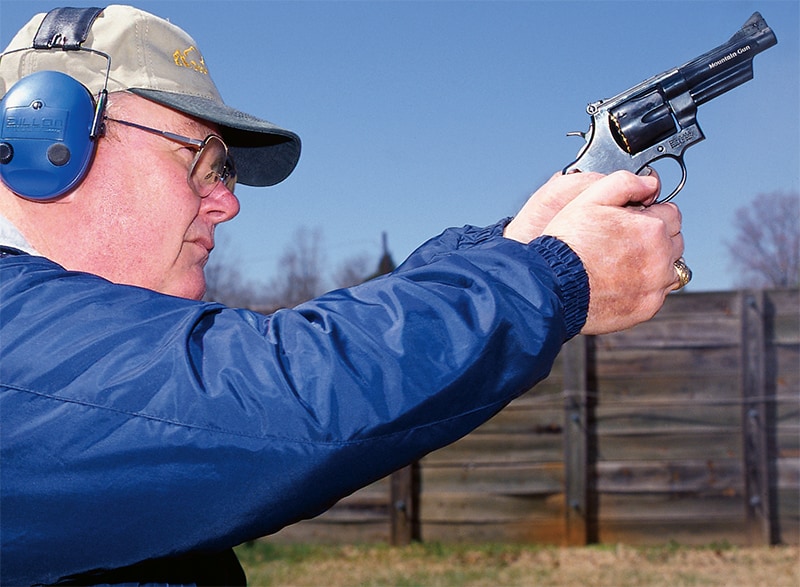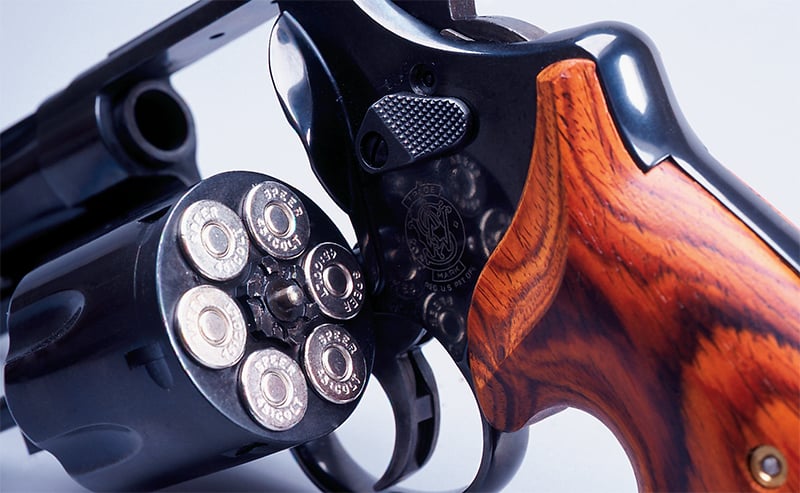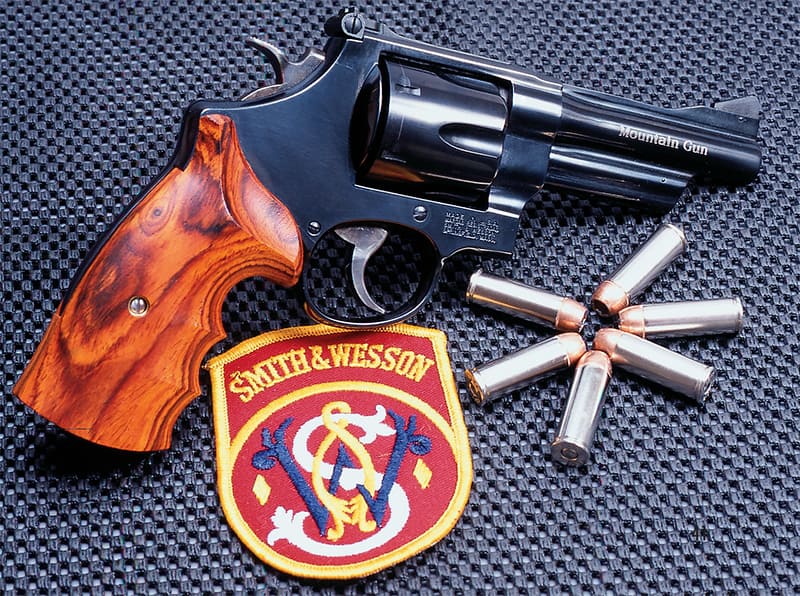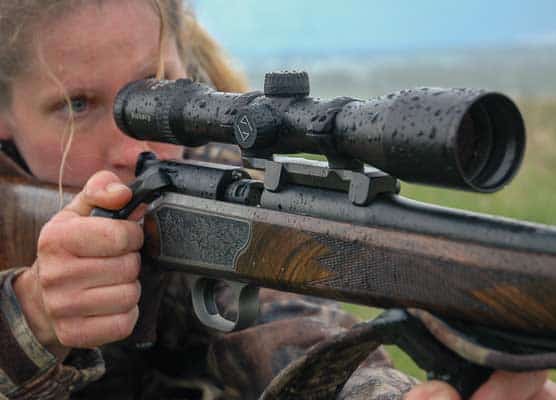Smith & Wesson's .45 Colt Mountain Gun
E-Gads! A Blue-Steel N-Frame
Oh happy day! S&W has returned to their classic roots: blue steel and wood stocks. Even though I understood the business reasons I was not entirely thrilled when S&W decided to make everything out of stainless steel. I was even less happy when they decided to make all their N-frame revolvers with round butts, but the worst thing of all was when they quit making the wood stocks that had been their trademark near-forever.
Sound business practices dictated all of those moves. Machining practices are not the same for carbon steel as they are for stainless, so that simplified life. Keeping both round and square butts in stock doubled the inventory requirement and outsourcing stocks (that’s what S&W calls grips) is economical too.
The Mountain Gun concept has a 4″ light barrel on a large frame revolver that comes and goes in the catalog. Almost always they have been chambered for the .44 Magnum and intended to appeal to campers or hunters who wanted a small but powerful handgun. The .44 Magnum surely qualifies there, but may just be too much of a good thing for some folks. Simply put, they’re not pleasant to shoot with full charge ammo.
History Lessons First
Several years ago S&W made a Model 625 Mountain Gun in .45 Colt and it was a bright idea. The .45 Colt cartridge may be the darling of the cowboy crowd these days but long before those games began, the cartridge was widely popular with folks who toted handguns as a daily necessity. It has an illustrious history dating back to 1873 and for awhile it was the issue round for our military.
The .45 Colt has never been a mainstay in the S&W product line and instead they focused on the various .44 caliber cartridges that had the S&W handle attached. During World War I, S&W made lots of 1917 models in .45 ACP and quite a few chambered for the British .455 Mk. II. Those turn up today fairly often and many have been re-chambered to accept the .45 Colt cartridge. In 1953, S&W made 200 of the 1950 Target Model for the .45 Colt and a minuscule number of the 1955 Model were made too, but it wasn’t until the Model 25-5 came along that the .45 Colt was anything other than a rarity. When the switch to stainless took over there were some 625-5 models.
The early .45 Colt revolvers — the 1950 Target and Model 25-5 — had well deserved reputations for lousy accuracy. Even though one of the 200 1950 Target .45s is one of my most treasured pieces, it won’t shoot for beans. The problem is at the chamber mouth — called the “ball end” in S&W-speak — which was simply too large to stabilize the bullet. Diameters of .457-.459” were common. When the .45 Colt began to be a little more popular, that was corrected and today’s revolvers are capable of joyous accuracy. The clue is to look for serial numbers beginning with “N” and then measure the ball end. Stainless steel guns and those that use S&W’s new three letter, four number (ABC 1234) serial numbering scheme are not afflicted with the malady. A very easy test is to just take a .45 bullet sized .451″ or .452″ and drop it in the cylinder. It should not fall through.
Retro-Modern?
So with a little history out of the way let’s look at the latest in .45 Colt hardware, the Model 25-13. The 25-13 is built to the newest specifications for all revolvers from S&W. On the left side of the frame just above the cylinder release is a little keyhole for locking the action. If you don’t turn it on you’ll never notice it. The cylinder release is also the new style with clearance on the bottom to allow for unimpeded use of speed loaders.
The hammer and trigger are the new MIM (metal injection molding) style. MIM parts get a bad rap from ignorant internet experts but the fact is if they didn’t look different we’d never know. You can see some molding lines but the parts have almost the same density of forged pieces and seem to last just as long too. In fact the single-action pull of this gun, at 4-pounds 2-ounces, is crisp and totally creep-free. The double-action pull is a robust 12 1/2-pounds and could use a little smoothing, but it will surely get better with use.
One of the most critical elements in revolver assembly is timing. S&W calls it “carry up” and it means the cylinder is squarely aligned with the forcing cone and locked in place before the hammer falls. This is one of those things that’s easy for the shooter to judge. Cock the hammer slowly and listen for the distinct click that comes when the bolt locks the cylinder. This needs to happen sometime before the hammer reaches the fully cocked position. I’ve always liked the cylinder to be locked up long before the hammer reaches full cock and that seems to be a characteristic of the new actions.
The outside is pretty nice too. The finish is a nicely polished blue. The right side of the barrel is laser-engraved with the “Mountain Gun” model and the right is roll-marked “.45 COLT CTG.” Sights are S&W’s standard adjustable rear and a plain black ramp at the front. The other very distinctive feature is the Ahrends grips. I know S&W calls them stocks but either way they’re nice. They are designed to make the round butt square, are a very comfortable size and the finger grooves are just right.
One of the things we always have to talk about is reliability, but with revolvers that’s almost a waste of ink. Revolvers are, by their very nature, reliable creatures and since I didn’t encounter a bad round of ammo there were no malfunctions. It’s easy to shoot and accurate too.
Ammo News
And this also gives us the opportunity to look at ammo and one particularly noteworthy new development. That is Speer Gold Dot ammo using a 250 gr. Gold Dot bullet. The Gold Dot is a plated hollowpoint having a great reputation for both expansion (over .70″) and accuracy. Accuracy results from the Ransom Rest are shown in the table but long before I got that far it passed the gong test. That is a 14″ diameter steel plate hung 70 yards downrange. I talk about the gong all the time but if you can keep shots on the gong, accuracy isn’t going to be an issue. I also shoot a lot of .45 Colt handloads consisting of 5.5 grains of Titegroup with a 255 grain lead semi-wadcutter bullet. The first shot ever from the Mountain gun hit it.
And speaking of handloads allow me a soapbox moment. Every manual now has loads designated for “Ruger or T/C only.” Neither Smith & Wesson nor I endorse these. It isn’t that the revolver isn’t strong, because it is, but both of us think if you want a magnum you should buy one.
The idea behind the Mountain Gun is a compact revolver for campers and such and I’m sure they’re used for personal protection too. But to me the .44 Magnum is a real fistful and in that regard the .45 Colt is a worthwhile opportunity. We’ve been convinced we must have magnum power to be adequately protected from man or beast and that simply isn’t true. A 250 or 255 grain .45 bullet moving along at around 800 fps packs a lot of momentum and is ever so much easier to shoot.






